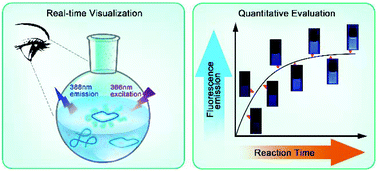Quantitatively monitoring polymer chain growth and topology formation based on monodisperse polymers†
Abstract
In this work, for the first time, polymer chain growth and topology formation was monitored and quantitatively evaluated using a maleimide-based fluorogenic probe based on a photo-induced electron transfer (PET) mechanism. A fluorene-containing monomer bearing terminal maleimide and thiol functional groups was rationally designed. The fluorescence of fluorene was effectively quenched by the adjacent maleimide group, which was proved by model reactions. Firstly, the correlation between molecular weight and fluorescence intensity was established as a calibration curve using precisely synthesized monodisperse polymers with varying numbers of repeating units via an iterative exponential growth strategy. Secondly, step-growth polymerization of the maleimide–fluorene–thiol monomer progressively consumed the maleimide group during polymer chain propagation and led to a gradual increase of fluorescence. This provides a quantitative and robust approach to monitor polymerization processes in situ. Moreover, cyclic oligomers were produced via intramolecular thiol–maleimide Michael addition in highly diluted solutions of linear precursors, and the cyclization process resulted in gradual enhancements of fluorescence intensity due to the elimination of maleimide groups. The cyclic oligomer content at a determined time can thus be quantitatively calculated based on fluorescence emission, enabling a real-time approach for monitoring/surveilling the cyclization process. We further applied this fluorogenic probe method to quantitatively monitor the formation of polymers with more complicated topologies, such as “cyclic-brush-like” macromolecules. This work demonstrates a facile, robust, and versatile platform for monitoring polymerization processes in situ, which may inspire and facilitate diverse molecular design and preparation in the field of precision polymer synthesis.



 Please wait while we load your content...
Please wait while we load your content...